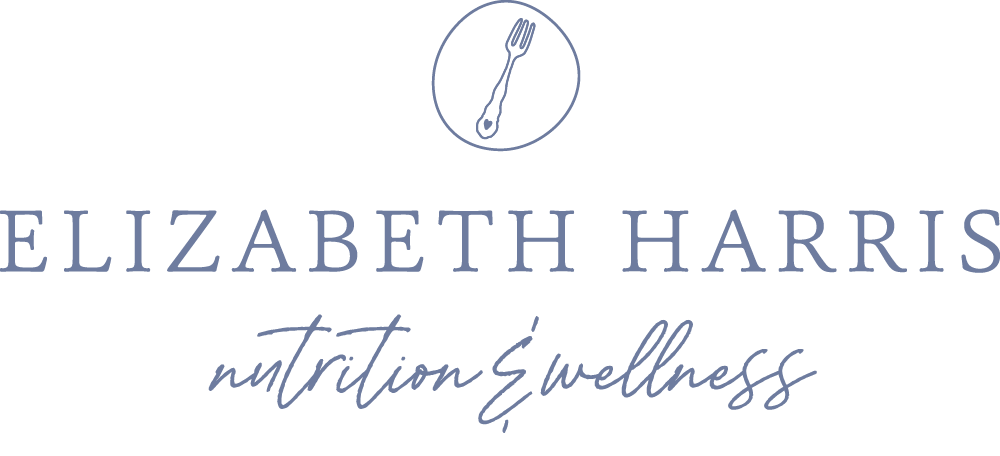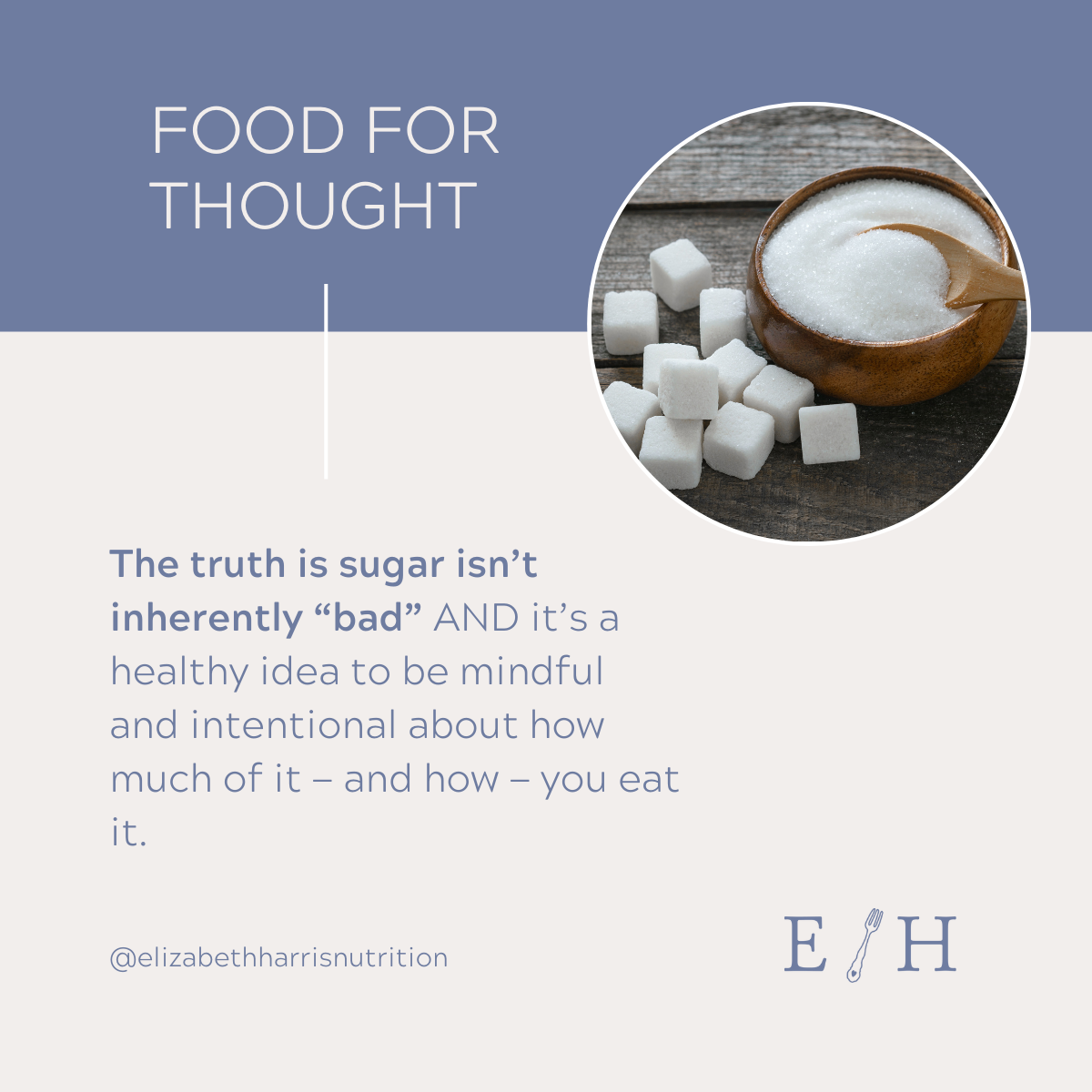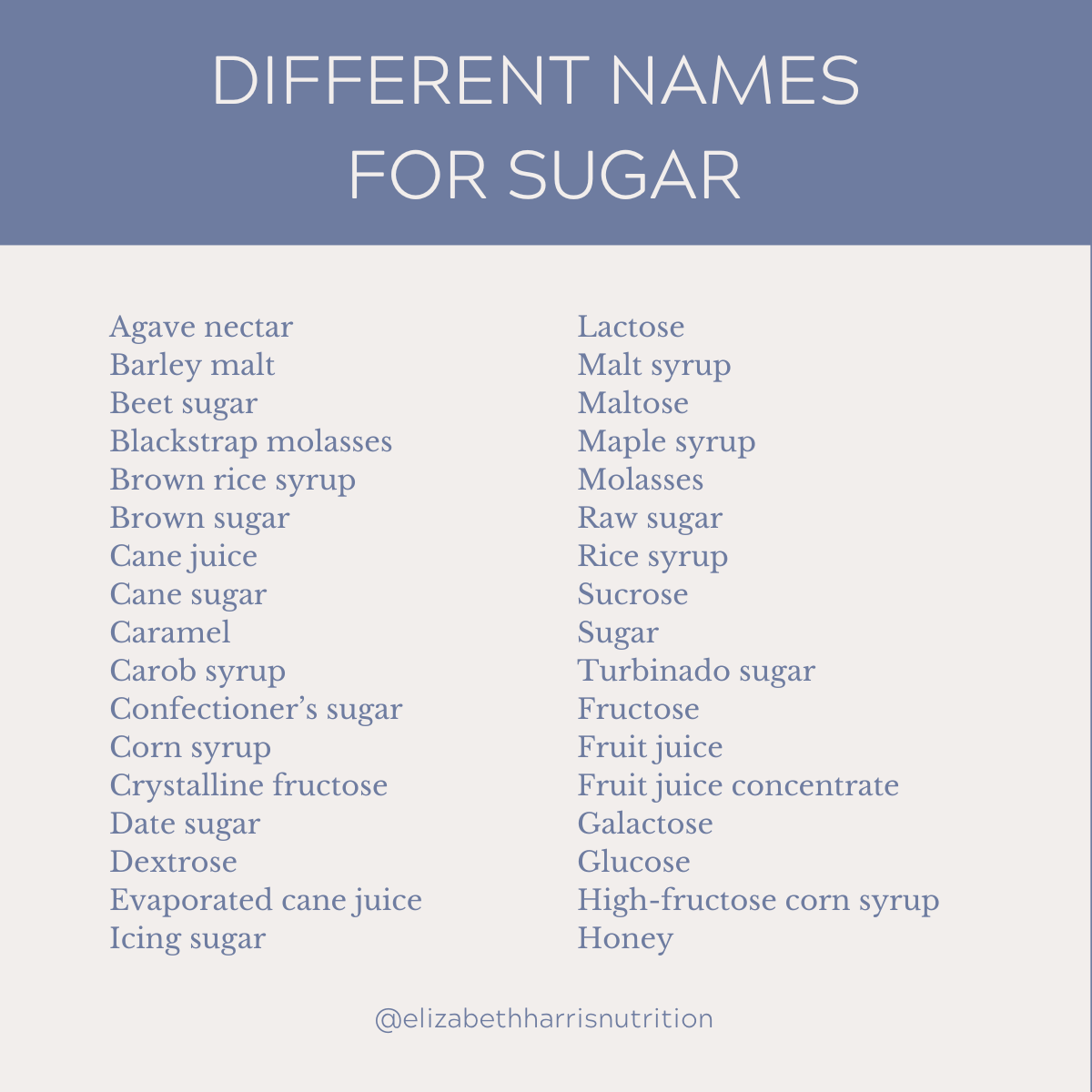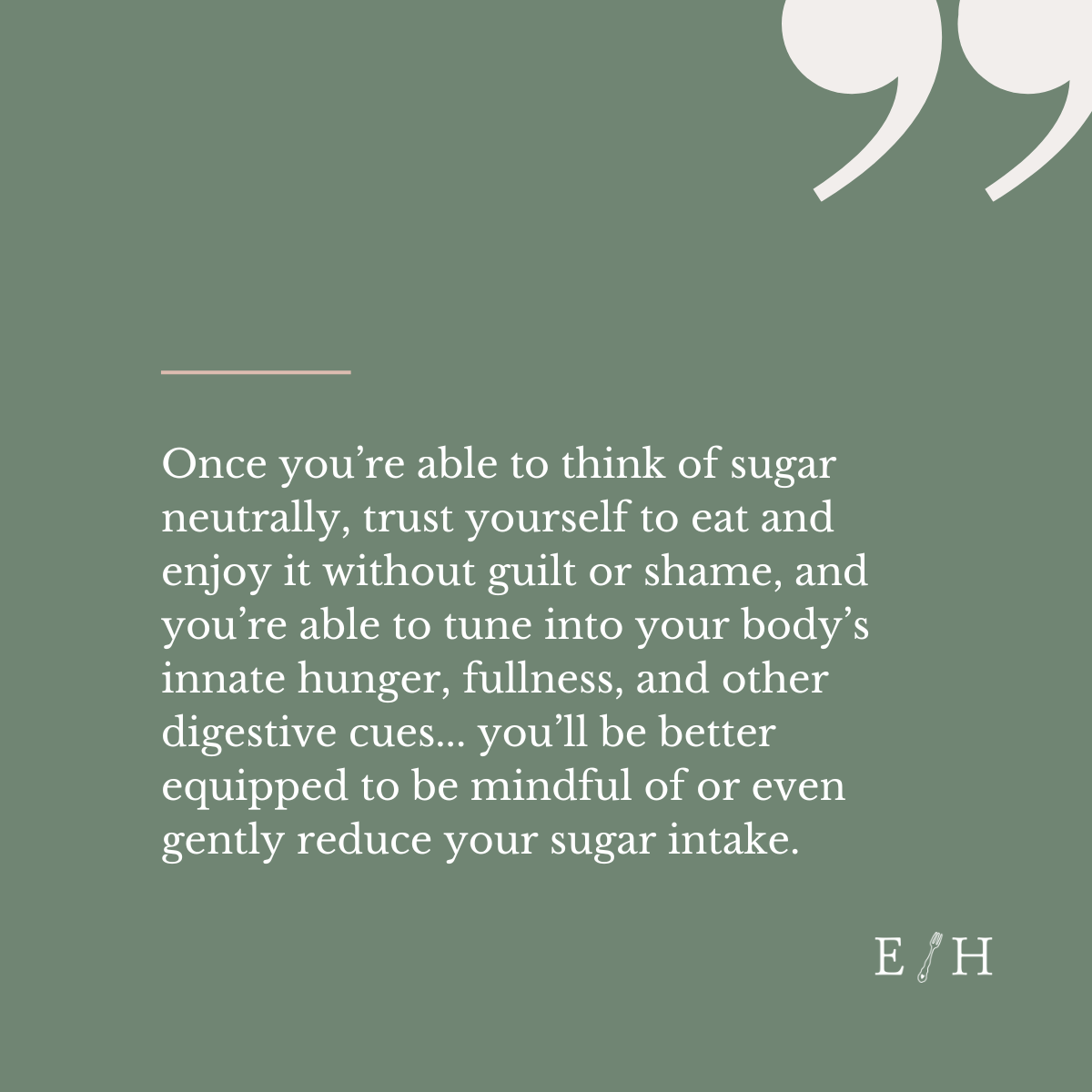Practical Ways to Cut Back on Sugar Without Jeopardizing Your Relationship with Food: Tips and Insights from An Intuitive Eating Dietitian
Is it really possible to cut back on sugar without feeling deprived or stuck in a restrictive, diet culture mindset? Is it even necessary?
As an Intuitive Eating aligned dietitian, people ask me for my thoughts and recommendations on sugar all the time. I’m sure I don’t have to tell you that sugar has a bad reputation and is often portrayed as a toxic substance in our diets that we should fear or strictly avoid. On the other end of the spectrum, many anti-diet advocates on social media may seem as though they’re endlessly glorifying and promoting eating sweets. If you’re confused about what it all means and how you can best move forward with sugar, you’re not alone.
The truth is sugar isn’t inherently “bad” and it’s a healthy idea to be mindful and intentional about how much of it—and how—you eat it. Let’s look at some facts about sugar and health, and then I’ll share some practical tips to help you enjoy sweets mindfully or even gently reduce your sugar intake without triggering guilt, restriction, or launching yourself into the all-too-common restrict-binge cycle.
The Facts About Sugar
When we talk about sugar, we’re really talking about different forms of carbohydrates. Some foods contain single units of sugars that are readily absorbed by your cells and others, often referred to as complex carbohydrates, are made up of longer chains of sugars that must be broken down by your body into single sugar molecules.
Fruits, vegetables, dairy, and grains all contain various forms of naturally occurring sugars which your body uses for energy. Diet culture, nutrition influencers, and celebrity doctors love to fearmonger around many of these foods, but the truth is they’re often nutrient-dense choices that are high in fiber and contain vitamins, minerals, and other compounds that have nutrition or health benefits.
Added sugars are ones that are intentionally added to processed foods and drinks or sugars that may get added to dishes during cooking, food prep, or at your table. These sugars can take many forms, including honey, syrup, agave, brown sugar, corn syrup, concentrated fruit juices, and many others.
All types of sugar, whether they’re natural or added to your foods, get broken down into those single molecules of sugar that are either used immediately for energy, converted to a storage form of energy in your liver and muscles, or as with all excess calories consumed, converted into fat stores.
Carbs are your body’s primary source of energy and one of the three macronutrients, along with protein and dietary fats, that our bodies need in larger amounts. So, despite all the fearmongering, our bodies need carbs (ie, sugar) to function optimally.
That said, it’s wise to be mindful of added sugar in our diets for a variety of health reasons. Diets high in added sugars are linked with higher rates of high cholesterol, triglycerides, and blood pressure along with increased risk for heart disease. They’re also associated with inflammation, oxidative stress, insulin resistance, and dental cavities.
There’s lots of controversy in the research over whether it’s the excess sugar itself that is harmful or some other not yet understood factor. One important reason for some of these negative health outcomes mentioned may simply be that higher intake of sugary foods leaves less room for more nutrient-dense options.
Top Sources of Added Sugar and How to Spot it on the Nutrition Facts Label
The primary sources of added sugar in our American diets are sodas and other sweetened beverages (like flavored coffees, juice, energy drinks, and shakes), as well as desserts, baked goods, sweetened cereals, and candy.
Added sugars are found in lots of unexpected places too, including yogurt, bread, sauces, dips, salad dressings, and prepared foods. Sugar may be listed by many different names on the nutrition facts label.
Fortunately, added sugars are now clearly listed as a separate line item on the nutrition labels of packaged foods so you can make informed choices.
Consider Your Relationship with Food Before Making Any Changes to Your Sugar Intake
If you’re concerned about your added sugar intake, it’s essential to pause and reflect on your relationship with food before you begin making any changes to your diet. This may seem unnecessary, but it’s a crucial step for your mental and emotional health and long-term success with your nutrition.
Your relationship with food matters because it’s an integral part of your health and wellbeing. You can think of it like the foundation of a house. If you try to build a house on a faulty foundation, that structure will probably not stand the test of time. Likewise, if you try to change your eating habits and your underlying relationship with food needs healing, those changes are unlikely to be sustainable or supportive of your overall wellbeing.
So, how do you know if your current relationship with food supports the gentle nutrition step of evaluating or lowering your sugar intake? Here are a few things to consider:
1. Assess Your Feelings Around Food: Do you feel stressed, anxious, or guilty when you think about or eat something sweet? Are you shamefully eating sweets in secret because you don’t want others to judge you? Do you attach moral value to the foods you eat, thinking of different foods or even yourself as ‘good’ or ‘bad’ depending on what you’re eating? If so, these emotions may be signs that your relationship with food needs more healing.
2. Consider your food rules: Do you have rigid rules about what, when, or how much you’re ‘allowed’ to eat? Does it feel as though you’re frequently negotiating with yourself about how many cookies you can have or how many minutes you’ll have to spend in the gym to earn or make up for eating something sweet? When you break the rules you’ve set for yourself, does it trigger negative self-talk or self-criticism? If you’re nodding your head yes, you may want to reach out to an Intuitive Eating counselor for support with your relationship with food.
You may also find my free guide, Invisible Diet, a helpful tool to discover the hidden dieting practices and mindset blocks that may be keeping you stuck in an unhealthy or unhelpful relationship with food.
3. Observe Your Eating Patterns: Notice how you behave around sugary foods. Are they something you enjoy peacefully in amounts that feel good to you? Do you trust yourself to keep them in your house? Or do you frequently overeat them or feel out of control when they’re around? If it’s the latter, the Intuitive Eating step of making peace with food and practicing unconditional permission to eat all foods might help you regain your sense of self-trust and balance with your eating.
4. Reflect on Your Hunger and Fullness Cues: Can you tell when you’re truly hungry or when you’re comfortably full? Are you able to stop eating when you’re satisfied, or do you regularly eat past fullness? Strengthening your ability to listen to these cues is an important step to set you up for success with nutrition-focused changes.
If you’re realizing your relationship with food is not as healthy or supportive as you’d like it to be, do not despair. No matter how long you’ve been struggling with food, healing is entirely possible. If you’d like support to transform your relationship with food and prioritize gentle, flexible nutrition, you can book a free strategy call with me to chat about the options for individualized coaching or Intuitive Eating group support.
Once you’re able to think of sugar neutrally and trust yourself to eat and enjoy it without guilt or shame and you’re able to tune into your body’s innate hunger, fullness, and other digestive cues, you’ll be better equipped to be mindful of or even gently reduce your sugar intake. With this foundation in place, your efforts will come from a healthy place of self-care and body respect — which is the secret sauce for sticking with them.
Ready for Gentle Nutrition? Here Are Some Practical Ways to Reduce Your Sugar Intake
Before we jump into my tips, it bears emphasizing that all foods can fit in a health-promoting way of eating, including sweets. Enjoying delicious treats without guilt or shame supports your mental and emotional health just as vitamins and minerals support your body’s cells to function properly.
Tip #1: Choose Whole Foods Often
Instead of cutting back on sugar right away, try focusing on eating consistent, balanced meals and adding more nutrient-dense whole foods into your daily meals and snacks. Think: fruits, vegetables, whole grains, healthy fats, and lean proteins. When you sufficiently nourish your body with these foods regularly, you may be surprised to find that your cravings for sugar naturally reduce without having to force anything.
Tip #2: Read and Compare Food Labels
As mentioned earlier, the Nutrition Facts Labels on packaged foods list both added and total sugars. Added sugars indicates how many grams of sugar have been added to that food and total sugars combines both added and natural sugars found in that product. Four grams of sugar is the equivalent of one teaspoon, so if the label states there are 16 grams of added sugar that means there are four teaspoons of added sugar in that food.
Being an informed consumer can help you gently lower your added sugar intake. If you’re choosing between two similar products such as salad dressings or cereal, for example, and you’ll still enjoy eating the one with less added sugar—and choosing that one won’t trigger feelings of deprivation or restriction—go for the easy, nutrition-boosting swap!
Tip #3: Be Mindful of Your Beverages
Many drinks like sodas, sweet teas, flavored coffee drinks and juices are hidden or underestimated sources of added sugar. Rather than cutting them out completely or cold turkey, I suggest you start by simply becoming aware of how much sugar you’re getting from these beverages. If your intake feels out of alignment with your needs and goals, you can try:
gradually reducing the number of these beverages you consume each day
slowly lowering how much sugar you’re adding to them
diluting sweetened drinks with water
experimenting with lower sugar versions of your favorite drinks
This will allow your tastebuds to adjust to less sweetness without leaving you feeling deprived.
For alternative options, you can try adding a splash of juice to sparkling water, drinking herbal teas, or adding a twist of lemon or a dash of cinnamon to flavor teas or other drinks. You might also have fun infusing water with a variety of fruits and/or herbs for extra flavor.
Tip #4: Experiment With Lowering the Sugar in *Some* Recipes
Much like with sodium, you have more control over how much sugar you use in your meals when you prepare foods at home. If you’re not baking and your recipe calls for sweetener, you may be able to eliminate it entirely or use less than what the recipe calls for without much noticeable change in the final dish.
In some recipes you may be able to swap out some added sugar with naturally sweet ingredients like mashed bananas, dates, applesauce, or even canned pumpkin or sweet potato.
But remember, for most people, there’s plenty of room to enjoy some yummy baked goods mindfully—and guilt-free—without having to monkey around with the recipe!
Tip #5: Have Fun with Herbs and Spices
Herbs, spices, and extracts like cinnamon, nutmeg, vanilla, ginger, basil, and mint can enhance the flavors of your food and make them taste more satisfying without relying on added sweeteners. For example, you might add a bit of vanilla extract, cinnamon, or even chai spice to a smoothie in place of honey. Try sprinkling cinnamon on sweet potatoes instead of adding marshmallows or sweetener or, rather than adding sugar to a bowl of berries, experiment with adding slivered mint or basil. Whatever you try, be creative and have fun with it.
Tip #6: Buy Unsweetened Foods and Add Your Own Sweetener
Much of the time, you can opt for unsweetened or plain versions of common foods like yogurt, nut butters, cereals, oatmeal, applesauce, cottage cheese, tomato sauce, and nut milks. Add flavor and natural sweetness with fruit, cinnamon, vanilla, or simply less sugar than you’d find in the ready-made, pre-sweetened versions.
Another idea is to make a lower sugar trail mix with unsweetened nuts, dried fruits, or shaved coconut. You can add a nutrient-dense whole grain cereal and dark chocolate chips or even include fresh berries at the time of serving for added sweetness.
Tip #7: Get Good at Mindful Eating
Mindful eating encourages a deeper awareness of your eating habits and can give you critical opportunities to pause, tune into your body, and make more intentional choices. By slowing down and paying close attention to the sensory experiences of eating, including the tastes, textures, temperatures, and aromas of your food, you may find it easier to be attuned to your hunger and fullness cues and satisfaction signals, which in turn will make it easier to stop eating when you’re comfortably full.
Mindful eating can also help you pause before reaching for sugary foods out of habit or help you non-judgmentally consider whether you’re experiencing physical or emotional hunger, while affording you the extra beat you need to decide what you most need and how you can best support yourself through whatever it is you’re feeling. As you get better at being present in the current moment, you may find it easier to make more conscious decisions about your sugar intake.
Tip #8: Walk Your Choices Backwards
I teach my clients to remind themselves they’re allowed to have any foods they want without guilt or shame. With that key aspect of permission to enjoy their food firmly rooted in their mindset, I then suggest they walk their food choices backwards by asking themselves these key questions:
“Do I really want this food right now?”
“If so, how can I eat it in a way that feels good?”
For example, sitting down at a table with plates, utensils, and pretty placemats may be more enjoyable than grabbing food out of the carton or the bag as you’re driving around town or running around cleaning your house. Or you might enjoy a dessert food more after you’ve eaten a balanced meal or when you can sit down to eat it mindfully.
Tip #9: Aim For Progress Not Perfection
There is no perfect diet; some foods do a better job of nourishing your body and others do a better job of nourishing your soul. We need both in a balanced and pleasurable approach to nutrition and health. The goal for most of us isn’t to eliminate added sugar entirely, but rather to be mindful and intentional about how we eat it.
If you’re trying to reduce your sugar intake, you can set yourself up for greater success by making gradual changes. Practice listening to your body and being patient with yourself as you build these new habits. Start by incorporating just one or two ideas into your routines and when you’re comfortable with those, you can gradually layer in some of the other ideas I’ve shared. Lastly, be sure to measure your progress against your starting point not your end goal so you can see how far you’ve come and celebrate all the small wins along the way!
Being intentional about how much sugar you consume is an important aspect of your nutrition and a helpful way to support your metabolic function and overall health. Unfortunately, far too many people fail to take your relationship with food into account when discussing or making recommendations about sugar intake. Please remember that how you eat is just as important for your health and wellbeing as what you eat. Pleasurable, guilt-free eating is health-promoting too!




